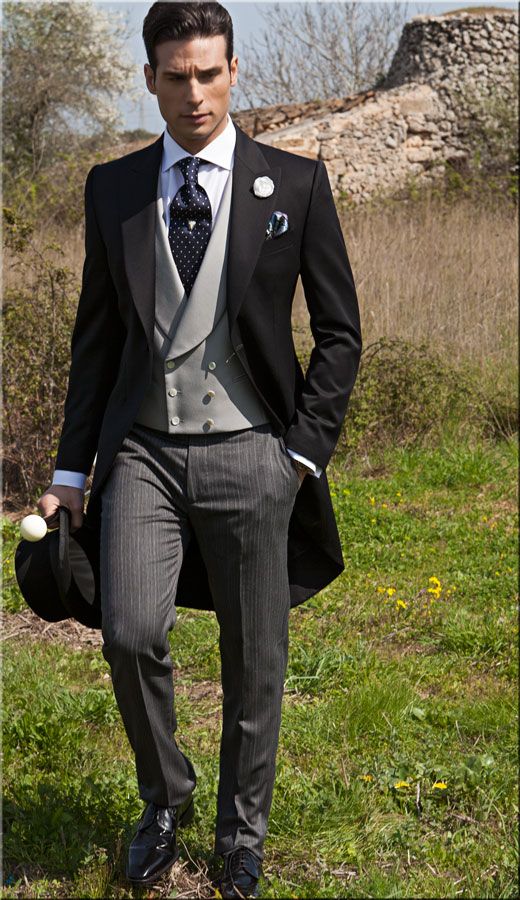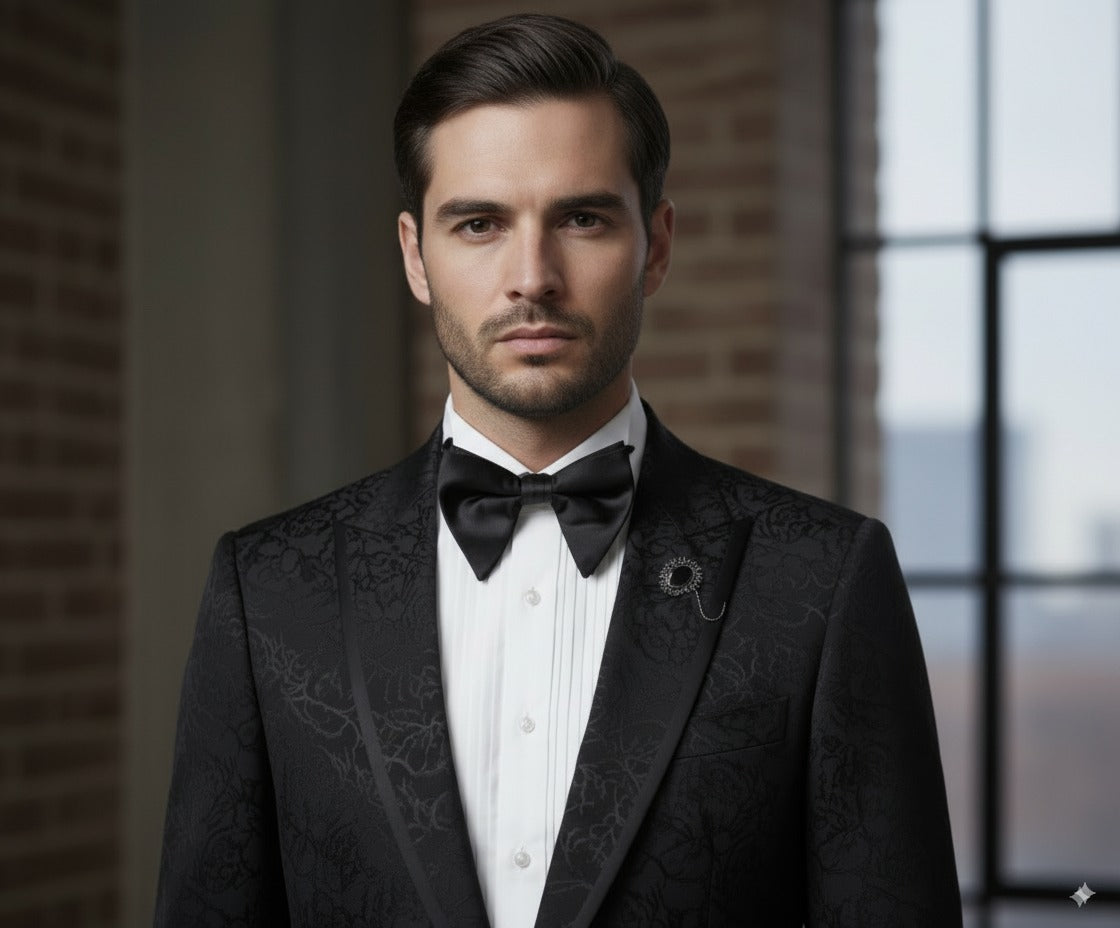
Suit Facts & Formal Dress Codes.
Share

- The current styles were founded in a period of sartorial revolution during the early 19th century. This sharply changed the elaborately embroidered and jewelled formal clothing into the simpler clothing of the Regency period (1811-20), which gradually evolved to the stark formality of the Victorian era (1837-1901). It was in the search for more comfort that the loosening of rules gave rise in the late 19th century to the modern lounge suit.
- In the early 1900’s when the future Edward VII was Prince of Wales he became so fat that he couldn't do up the bottom button on his waistcoat & jacket so court followed suit to make him feel better about his body image, men have worn it this way ever since.

3.The Cravat & Neck Tie - In the early 1630s, during the Thirty Years War, Croatian soldiers in support of France were presented to the French King Louis XIII. The Croats wore colourful, knotted neckerchiefs as a part of their uniform, which attracted their French partners who were accustomed to wearing starched, ruffled collars. Apart from its decorative purpose, the necktie was more practical than these stiff collars and could protect the soldiers’ shirts and buttons. By the time Louis XIV came to the throne, these ties became fashionable in France. Military personnel, French courtiers, and ordinary French people began sporting the accessory in various colours and fabrics. Some people even believe that “cravat”, the French word for “tie”, was even just a corruption of “Croat”, as the style was adopted from the Croatians.

The neckwear grew to be a stylish accessory for the well-dressed gentleman who wore it in every imaginable colour and style. There were cravats of tasselled strings, ruffled collars, ribbon, embroidered linen, cotton, and an abundance of lace. It was then a couple of centuries later during the industrial revolution that gentlemen started to favour a more simple form of tie, tied in a 4 fold knot that the neck tie we are familiar today was first seen.
- The history of the ticket pocket is torn between the start of the steam train age in Britain when travellers needed an extra pocket to have their ticket easily accessible, and also apparently worn on riding jackets in America so that riders could readily access their coins.

5. The cummerbund, one of the weirder of the men's accessories was originally used to collect crumbs and pieces of food whilst eating; this is why the pleats should be worn upwards.

6.Gabardine weave - such as our WR cloth range - invented in 1879 by Thomas Burberry founder of the Burberry fashion house. It is tightly woven as a warp-faced steep or regular twill with a prominent diagonal rib, originally woven for water repellent properties it was popular with polar explorers including the first man to reach the south pole and George Mallory on his ill-fated Everest attempt.

7.Worsted Wool - Rather than going directly into a spinning process, worsted wool is first combed in a carding process to remove any short and brittle fibres. This leaves only the longer strands of the fibre to undergo the spinning process, producing a smooth yarn that has a high durability. Owing to the strength of wool that undergoes the worsting process, the fibres can be woven into a finer material that is more wrinkle resistant than many other fabric choices. This makes this smooth fabric an ideal choice for garments that need to hold their shape, and perhaps not only be wrinkle-free but also hold an even crease as well.

8.Merino Wool - The merino is one of the world’s most ancient breeds of sheep. It’s wool although ‘fluffy’ in appearance; the fibres of a merino fleece are lighter than any other sheep’s wool. Some people with sensitive skin feel less or no irritation when wearing a merino wool item of clothing.

9. Your suit will be made by a number of tailors – First is the master cutter who will draft up your pattern, next is the under cutter who will cut out all the small bits. We have our own canvas maker who will hand make all the internals that help a suit drape well. There are separate jacket tailors, trouser tailors, shirt tailors and overcoat tailors who will actually make the garment. Then there are the finishing tailors who will do a lot of handwork such as buttonholes and prick stitching.

10.Blended cloths are made of 3 or more fibres, which gives the cloth the benefits of each of the blended materials, with modern technology leading to ever innovate blends they are becoming known as smart fabrics. Weavers blend cloth for a number of reasons such as to make them more durable, breathable, warm, luxurious.

Wedding Suits:

- You should look like you’re getting married, not giving a PowerPoint presentation. Avoid dark grey and deep navies, and shell out somewhat more than you may be used to choosing a great cloth, it will pay off.
- Should I wear a 3 piece to my wedding? Yes! It will stop you looking like you're going to work, keep you looking smart if you ditch your jacket for some drunken dancing and help you stand out from all the other guys at the wedding. Don't be afraid to ask your other groomsmen to only come in 2-piece!
- Want to wear your wedding suit after the big day? Separate the garments, ditch the waistcoat and wear as a 2 piece, use the jacket as a blazer, wear the waistcoat with jeans or trousers with a shirt.
- If your fiancé is not with your customer when choosing you wedding suit it would be advisable to have swatches of lining and cloth sent to the customer for them to check.
- There is often a colour theme to weddings and it can be tempting to match ones lining to the flowers/place cards/bridesmaid dresses & balloons. Be wary when doing this if the colour is a very specific shade, say teal, it might not be a 100% match to our teal coloured linings.
Formal Dress Codes:

- Black tie - worn for events after 6pm - For men, the elements of black tie are a suit, of black or midnight blue wool, in which the jacket lapels and trouser braid are of silk or other contrasting material, a white dress shirt, a black bow-tie, an evening waistcoat or cummerbund, and black dress shoes.
- Black tie optional - A Black Tie Optional or Black Tie Invited gives you the option of wearing a dinner suit or formal dress, but it should clue you into the formality of the event, meaning a dark suit and tie would be your other option.

- White tie (or full dress, evening dress, full evening dress; slang top hat and tails or white tie and tails, tail suit, tails) The chief components are the black dress coat commonly known as an evening tailcoat, white bow tie, white waistcoat and starched wing collar shirt.
As evening dress, white tie is traditionally considered correct only after 6:00 p.m. The equivalent formal attire for daytime events is called morning dress.
- Morning dress - is the daytime formal dress code, consisting chiefly for men of a morning coat, waistcoat, and striped trousers. Men may also wear a popular variant where all parts (morning coat, waistcoat and trousers) are the same colour/material, often grey and usually called 'Morning Grey' to distinguish it.


- Semi-formal - In the daytime (before six o'clock), the semi-formal code requires for men a black tail-less coat with formal (striped or checked) trousers. This combination is a less formal version of morning dress - which features a longer, cutaway morning coat. This semi-formal ensemble is sometimes referred to as a "stroller" in North America. For evening wear, the corresponding code is black tie.


- Informal attire, also called international business attire or Western business attire is a dress code, typified by a suit and necktie. On the scale of formality, informal attire is more formal than casual but less formal than semi-formal. It is more presentational than semi-casual, but offers more room for personal expression than semi-formal dress. Informal should not be confused with casual, not even smart casual — in loose common usage, many people refer to informal dress as semi-formal or formal and formal dress (in the technical sense — that is, white tie, black tie, and similar) as very formal.

- Smart casual - Smart casual is an ill-defined dress code that is generally, neat, yet informal attire. The locality, type of event, context or culture constitutes the various interpretation of the dress code and therefore the designating of certain clothing pieces as smart casual is disputed, for example, jeans.

- Business casual - Business casual is an ad hoc dress code in professional and white-collar workplaces in Western countries.
Clothing that falls under the category of business casual includes chinos, blazers, as well as short-sleeved polo shirts and long-sleeved shirts.

“PEOPLE WILL STARE. MAKE IT WORTH THEIR WHILE” -Harry Winston-
A Hand Tailored Suit, the tailoring company offering you a slice of London’s Savile Row for a cut of the cost. Bespoke custom clothing for Men, Women & Children, we offer only the finest of cloths from only the finest of cloth merchants from around the world. Call us in the UK 0121 368 1052/ or IRE +353(0) 1 513 6665 Our UK studio’s in Belfast and Birmingham, and our Irish studio’s in Dublin, Cork and Limerick, click here to contact us.

